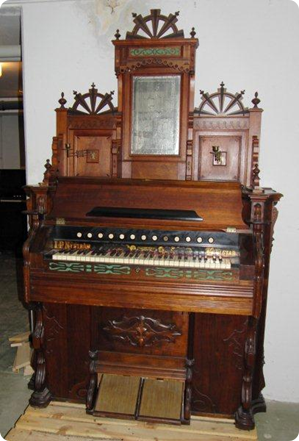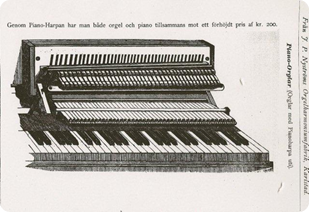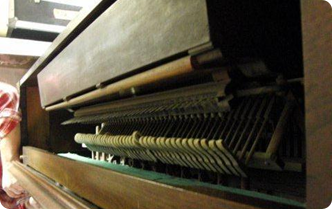klaverens hus 
We are still working with this site. Plaese, check the changes regularly.  Ändra den här texten genom att klicka på "Redigera" |
Mason & Hamlin – J.P. Nyström c. 1875/c. 1895 (KH 546)
A high mirror top reed organ attracts attention by its peculiar design. It bears the name J.P. Nyström but gives in spite of this the impression that there is a stylistic imbalance. No doubt, the furniture style is American, but the top and the organ don’t seem to belong together. Spontanously, the idea comes to one’s mind that the organ itself, made of American walnut, at a later time has been equipped with a high top with partly other stylistic ideals
Preliminary, our organ has been dated to c. 1875 (Gellerman, e-mail 28th November 2010) and should be a proof of an early Swedish import of suction reed organs from the US. The next question is who imported it to Sweden. Most probably, it was Nyström. The Mason & Hamlin factory is mentioned in the Nyström 60th years celebration publication 1865-1925 (p. 9) where it is looked upon as important, even if Nyström has misunderstood the history of the origin of suction bellows. It is a plausible theory that Nyström imported reed organs made by Mason & Hamlin and that this very copy was unsold for some reason. Far later Nyström had the idea of rebuilding this instrument by adding a high mirror top that has certain details in common with his ‘Style 60, 61’ in the 1895 catalogue (p. 32). The signature of the instrument has been used in the period c. 1895 to 1902, when the factory became a joint stock company. The rebuilding may have been made somewhere in these years, most probably around 1895.
The original organ has a certain stop built into the case. In his 1886 catalogue Nyström offers ‘Piano-Organs’, i.e. ‘Organs equipped with a Piano Harp’. This kind of stop has a 3½ octave set of hammers which don’t hit strings but metal rods, giving a bell-like sound. Experiments in order to replace piano strings by other materials (glass, metal) are old and well-known. Something similar to the ‘piano-organ’ had been tried by J.B. Cramer & Co. in London (‘steel keyboard’, serial no 223 included in the collections of the Stockholm Music and Theatre Museum, inv.no M 1793). A Swedish patent of 1841 obtained by J.E. Bäckström, organist and town cashier at Strömstad, uses ‘non stretched bodies shaped as usual tuning forks, one for each tone, which are preferably made of fine steel, well elastic hardened.’ The idea was not new. Already in 1803, the Danish instrument maker Peter Riffelsen had invented a Melodica where tuning forks were brought to swing against a rotating metal roller (Falcon Möller 1983, p. 59). European reed organs with pressure bellows have the effect ‘percussion’ which consists of small hammers hitting the reeds. What we here have is on the other hand an American patent of 15th December 1874. The Piano Harp Action belonged to the Mason & Hamlin Style 302 and the factory should be the patent holder (Gellerman 1973, p. 58). The model is rare not only here in Sweden but also in the US.
Literature:
Klaverens Hus, Hemmansvägen 11 826 62 NORRALA +46722820431 info@klaverenshus.se www.klaverenshus.se
|
 At first, it should be stated from where the organ part comes, whether from the Nyström factory as stated by the name board or from another factory and in that case which one. As might be expected it is not a Nyström organ but an American one, by the Mason & Hamlin factory, Style 302 (Robert F. Gellerman’s database
At first, it should be stated from where the organ part comes, whether from the Nyström factory as stated by the name board or from another factory and in that case which one. As might be expected it is not a Nyström organ but an American one, by the Mason & Hamlin factory, Style 302 (Robert F. Gellerman’s database 
